Choose Your Activity
Choose Where You Sleep
Vietnam Wildlife Watching
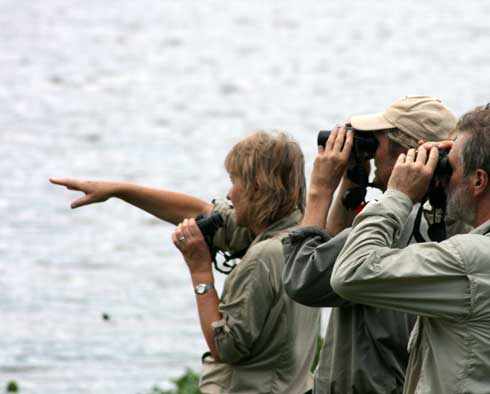
Choose where you sleep
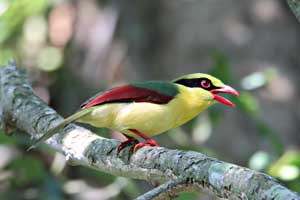 Vietnam, a country that for a generation was associated with suffering, has risen phoenix-like from the ashes of war to become one of Asia’s dynamic rising tigers. Vietnam’s economy is booming and travellers from around the world are discovering its ancient culture, picturesque countryside, deserted beaches, delicious cuisine and its friendly, smiling people.
Vietnam, a country that for a generation was associated with suffering, has risen phoenix-like from the ashes of war to become one of Asia’s dynamic rising tigers. Vietnam’s economy is booming and travellers from around the world are discovering its ancient culture, picturesque countryside, deserted beaches, delicious cuisine and its friendly, smiling people.
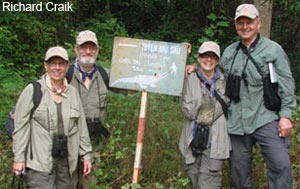 But what may come as the real surprise to many birders is that Vietnam has the highest number of endemic bird species on mainland South-East Asia. There are currently twelve species of bird that are found only in Vietnam, though this figure is liable to change at any time as taxonomic changes are made and species are 'split'. In addition to these twelve endemics there are many more near endemics, bird species restricted to Vietnam and a few neighbouring countries.
But what may come as the real surprise to many birders is that Vietnam has the highest number of endemic bird species on mainland South-East Asia. There are currently twelve species of bird that are found only in Vietnam, though this figure is liable to change at any time as taxonomic changes are made and species are 'split'. In addition to these twelve endemics there are many more near endemics, bird species restricted to Vietnam and a few neighbouring countries.
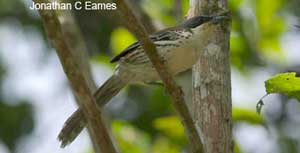 Since the 1990s the number of birders discovering Vietnam has risen steadily and its unique and exotic avifauna of over 850 species make it an enticing destination for the travelling birder.
Since the 1990s the number of birders discovering Vietnam has risen steadily and its unique and exotic avifauna of over 850 species make it an enticing destination for the travelling birder.
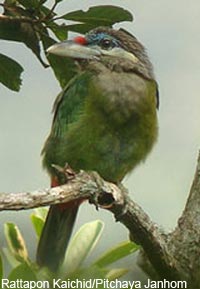 Vietnam has some great birding sites, many of which are protected within the country’s national park system. A few however, including some of the extremely important sites on the Dalat Plateau, are not within protected areas and the long term survival of these sites, their birds and associated fauna and flora is by no means guaranteed.
Vietnam has some great birding sites, many of which are protected within the country’s national park system. A few however, including some of the extremely important sites on the Dalat Plateau, are not within protected areas and the long term survival of these sites, their birds and associated fauna and flora is by no means guaranteed.
Birding sites in the south of the country include areas of lowland evergreen and semi-evergreen forest at Cat Tien National Park, montane evergreen forests on the Dalat Plateau and natural grasslands, mangroves and mudflats in the Mekong Delta.
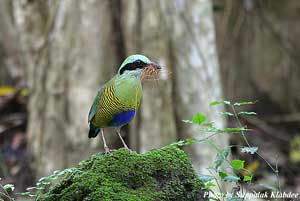 The habitats in the central region vary from dry dipterocarp forest at Yok Don National Park to lowland and montane evergreen forest at Bach Ma National Park and Lo Xo and Mang Den and limestone forest at Phong Nha-Ke Bang National Park.
The habitats in the central region vary from dry dipterocarp forest at Yok Don National Park to lowland and montane evergreen forest at Bach Ma National Park and Lo Xo and Mang Den and limestone forest at Phong Nha-Ke Bang National Park.
In northern Vietnam habitats range from coastal mangroves and mudflats at Xuan Thuy National Park in the Red River Delta, to lowland evergreen forest on limestone at Cuc Phuong National Park, lowland and montane evergreen forest at Tam Dao National Park and Ba Vi National Park and the upper montane and sub-alpine forests of Sapa.
Geography
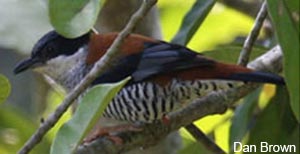 Located in mainland South-East Asia bordering Cambodia and Laos to the west, China to the north and the South China Sea to the east, Vietnam is a long thin strip of a country with over 3,000 kilometres of coastline.
Located in mainland South-East Asia bordering Cambodia and Laos to the west, China to the north and the South China Sea to the east, Vietnam is a long thin strip of a country with over 3,000 kilometres of coastline.
At each end of the country are densely populated fertile lowlands, the Red River Delta in the north and the Mekong Delta in the south, where much of the country’s rice is grown. These two deltas are connected by a narrow coastal plain behind which the Truong Son or Annamite mountain range runs virtually the whole length of the country.
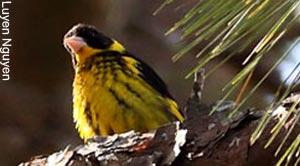 In the far north-west of the country are the Hoang Lien mountains and Vietnam’s highest peak, the 3,143 m high Mount Fan Si Pan, while further south the Kontum Plateau and Dalat Plateau form the Central Highlands. The Dalat Plateau is of special interest to birders being home to several endemic species and distinct subspecies of more widely-spread birds.
In the far north-west of the country are the Hoang Lien mountains and Vietnam’s highest peak, the 3,143 m high Mount Fan Si Pan, while further south the Kontum Plateau and Dalat Plateau form the Central Highlands. The Dalat Plateau is of special interest to birders being home to several endemic species and distinct subspecies of more widely-spread birds.
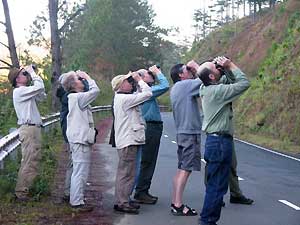 Birding combination tours
Birding combination tours
If you are not looking for a full-on birding tour or are travelling with a non-birding partner or friends, we can create a personalised tour for you combining the best of Vietnam’s birding with the best of its culture including historical sites, river cruises, ethnic minorities, cuisine, beaches, mountain retreats, spa resorts, cycling, in fact whatever you want.
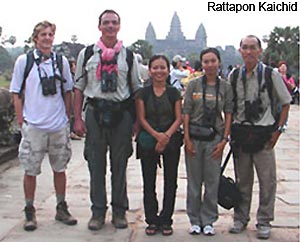 Birding & combination tours to Cambodia, Laos & Thailand
Birding & combination tours to Cambodia, Laos & Thailand
We can also tailor birding and birding combination tours to Cambodia, Laos and Thailand. Combine your Vietnam birding trip with an extension to Cambodia for the critically endangered Giant and White-shouldered Ibises and Bengal Florican and marvel at the magnificent Angkor Wat temples. Head to Laos to explore the peaceful mountain kingdom of Luang Prabang or search for the bizarre Bare-faced Bulbul in the limestone hills of southern Laos. Or extend your trip to include Thailand with its wonderful national parks and idyllic beaches.
How fit do I need to be?
Anybody with a reasonable level of fitness can enjoy birding in Vietnam but to get the most out your tour requires a modest amount of physical activity. There may be walks of up to 10 kilometres/6 miles on some days and temperatures will often climb to over 30° Celsius/90° Fahrenheit by the late morning. Birds in tropical climates are most active in the cooler periods of the day from dawn to mid-morning and from late afternoon to dusk so early starts are required to maximise our chances of finding our target birds.
Bird Habitats
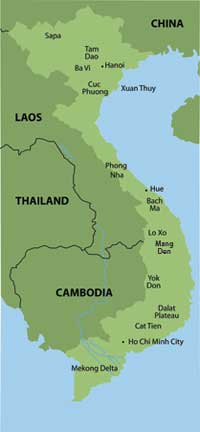 Evergreen forest
Evergreen forest
Evergreen forest is the natural forest type of areas of South-East Asia that experience a high annual rainfall. It is characterised by a high diversity of broadleaved tree species. Much of lowland Vietnam was originally covered in evergreen forest and though it is still the dominant natural forest type in the country the area it covers is just a fraction of what it would have been a century ago.
Evergreen forest can be divided into two distinct types, lowland and montane evergreen forest. Both lowland and montane evergreen forest are rich in bird species. Typical species to be found in lowland evergreen forest are woodpeckers, barbets, hornbills, trogons, cuckoos, bulbuls, babblers, flowerpeckers and spiderhunters.
At around 1,000 m above sea level montane evergreen forest takes over from lowland evergreen with oaks and chestnuts dominating. Montane evergreen forest can be split into two distinct types, lower montane evergreen and upper montane evergreen forest.
After 1,700 m there is a clearly defined transition to upper montane forest with tree species such as rhododendrons beginning to dominate. Vietnam’s montane evergreen forest holds a high diversity of bird species such as thrushes, flycatchers, nuthatches, tits, babblers and warblers. Some of Vietnam’s most sought after birds including the rare and endemic Collared Laughingthrush and Grey-crowned Crocias are to be found in montane evergreen forest.
Semi-evergreen forest
Semi-evergreen, or mixed deciduous, forest is similar to lowland evergreen forest but contains deciduous tree species such as dipterocarps in addition to evergreen. The birds found in this forest type are similar to those that inhabit lowland evergreen forest.
Deciduous forest
Deciduous forest can be divided into to two types, dry dipterocarp forest and mixed deciduous forest. Dry dipterocarp forest grows in drier areas on poor soil and is characterised by a canopy of dipterocarp trees and an open grassy under-storey. As there is no middle-storey in this forest type it is not as rich in bird species as evergreen or semi-evergreen forest. Several woodpeckers and parakeets are among the species favouring this forest type.
Mixed deciduous forests have a much more diverse vegetation with a variety of tree species, often bamboo, and a middle storey making this forest type richer in bird species than dry dipterocarp. Bird communities are similar to those found in lowland evergreen forest.
Limestone forest
Limestone forest is evergreen forest growing in areas of limestone and on limestone outcrops. This forest type is found in parts of northern and central Vietnam and is an important habitat for several limestone specialists such as Limestone Wren Babbler and Sooty Babbler.
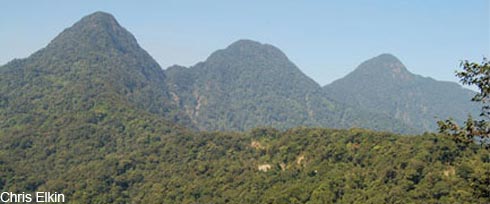
Coniferous forest
Vietnam’s native coniferous forest found on the Dalat Plateau is dominated by the species Pinus kesiya. Though the bird diversity of coniferous forest is low in comparison to other forest types it does hold some species that are not to be found in other habitats such as Eurasian Jay, Slender-billed Oriole, Red Crossbill and Vietnamese Greenfinch.
Natural grasslands
One of the most threatened habitats in Vietnam, natural grasslands, once covered large areas of southern Vietnam, particularly the Mekong Delta region bordering Cambodia. Much of the original grassland has been converted to agricultural land and only a few fragmented areas remain today. Important bird species that are restricted to this habitat include Bengal Florican.
Freshwater wetlands
Freshwater wetlands in Vietnam include rivers, lakes, marshes and seasonally flooded grasslands. The bird communities of all these habitats have suffered from human exploitation and encroachment. Typical riverine birds such as River Lapwing, Masked Finfoot, White-winged Duck and Blyth’s Kingfisher are rare and some are on the verge of national extinction in Vietnam.
Many artificial lakes and reservoirs have been created throughout the country in recent years but perhaps due to pressure from hunting or being just unsuitable habitat these attract few birds. The seasonally flooded grasslands of the Mekong Delta are disappearing fast as they are converted to agricultural land but the few remaining areas offer important winter feeding grounds for Sarus Crane.
Coastal wetlands
Vietnam’s coastal wetlands which include inter-tidal mudflats, mangroves and man-made habitats like salt pans provide feeding grounds for migrant shorebirds including several globally threatened species. Northern Vietnam’s Red River Delta in particular is an important wintering site for Spoon-billed Sandpiper, Saunders’ Gull and Black-faced Spoonbill.
Much of the Mekong Delta’s native mangrove forest has disappeared but what remains provides habitat for Oriental Darter and several other endangered species. The salt pans of central and southern Vietnam attract migrant waders and undisturbed beaches offer breeding sites for bee-eaters, plovers and terns. Some birds adapted to island life can be found on Vietnam’s offshore islands such as the Pied Imperial Pigeon on Con Dao Island off southern Vietnam.
Endemic Bird Areas
 Endemic bird areas, EBAs for short, are defined as areas to which at least two restricted-range bird species are entirely confined. BirdLife International has identified five EBAs in Vietnam: the Annamese Lowlands, the Dalat Plateau, the South Vietnamese Lowlands, the Kontum Plateau and the South-East Chinese Mountains.
Endemic bird areas, EBAs for short, are defined as areas to which at least two restricted-range bird species are entirely confined. BirdLife International has identified five EBAs in Vietnam: the Annamese Lowlands, the Dalat Plateau, the South Vietnamese Lowlands, the Kontum Plateau and the South-East Chinese Mountains.
The Annamese Lowlands EBA in north-central Vietnam has some fragmented areas of lowland evergreen forest with smaller areas of limestone forest but much of the original forest cover has gone. The Annamese Lowlands EBA supports nine restricted-range species of which three have only been found here: Annam Partridge Arborophila merlini, Edwards’s Pheasant Lophura edwardsi and Sooty Babbler Stachyris herbeti. Imperial Pheasant Lophura imperialis and Vietnamese Pheasant Lophura hatinhensis are also found only in the Annamese Lowlands but these are no longer considered true species.
The Dalat Plateau EBA in the southern Central Highlands has a natural vegetation of montane evergreen forest and coniferous forest and is home to six bird species entirely confined to the EBA: Collared Laughingthrush Garrulax yersini, Orange-breasted Laughingthrush Garrulax annamensis,Vietnamese Cutia Cutia legalleni, Grey-crowned Crocias Crocias langbianis, Black-crowned Fulvetta Alcippe klossi and Vietnamese Greenfinch Carduelis monguilloti.
The Dalat Plateau also supports several distinctive and endemic subspecies including Rufous-backed Sibia Heterophasia annectens eximia, Black-headed Sibia Heterophasia desgodinsi robinsoni, Blue-winged Minla Minla cyanouroptera orientalis, Black-throated Sunbird Aethopyga saturata johnsi and Red Crossbill Loxia curvirostra meridionalis.
The South Vietnamese Lowlands EBA, located in south-central Vietnam and a small part of south-eastern Cambodia, has a natural vegetation of lowland evergreen and semi-evergreen forest. The Orange-necked Partridge Arborophila davidi and Germain’s Peacock Pheasant Polyplectron germaini are restricted to this EBA.
The Kontum Plateau EBA is in the northern part of the Vietnamese Central Highlands and spills over the border into central Laos. The natural forest type is montane evergreen and it supports nine restricted range species, three of which were only discovered in the mid-1990s. The three recently discovered species, Black-crowned Barwing Actinodura sodangorum, Golden-winged Laughingthrush Garrulax ngoclinhensis and Chestnut-eared Laughingthrush Garrulax konkakinhensis, have so far only been found within the Kontum Plateau EBA.
The South-East Chinese Mountains EBA is home to five restricted range species, one of which, the White-eared Night-heron Gorsachius magnificus, has been recorded in northern Vietnam in recent years.
Endemic Birds & Specialities
Vietnamese endemics
There are now considered to be twelve true Vietnamese endemics if we count species found only in Vietnam. Two species, Imperial Pheasant (Lophura imperialis) and Vietnamese Pheasant (Lophura hatinhensis), are no longer considered true species. Imperial Pheasant is now thought to be an Edwards’s x Silver Pheasant hybrid and is considered an invalid taxon by BirdLife International. Vietnamese Pheasant is most likely just a form of Edwards's Pheasant.The twelve endemic species are:
- Annam Partridge Arborophila merlini
- Edwards’s Pheasant Lophura edwardsi
- Orange-breasted Laughingthrush Garrulax annamensis
- Collared Laughingthrush Garrulax yersini
- Golden-winged Laughingthrush Garrulax ngoclinhensis
- Chestnut-eared Laughingthrush Garrulax konkakinhensis
- White-throated Wren Babbler Rimator pasquieri
- Pale-throated Wren Babbler Spelaeornis kinneari
- Vietnamese Cutia Cutia legalleni
- Black-crowned Fulvetta Alcippe klossi
- Grey-crowned Crocias Crocias langbianis
- Vietnamese Greenfinch Carduelis monguilloti
Near endemics and specialities
Many of the most sought after birds in Vietnam are Indochinese endemics and are only found in Vietnam and Cambodia or Laos. Other specialities are species whose ranges are limited to Indochina and Thailand, China or Myanmar, or are globally threatened species that over-winter in Vietnam. Near endemics and specialities include the following species:
- Orange-necked Partridge (Vietnam & Cambodia)
- Siamese Fireback (Vietnam, Cambodia. Laos & Thailand)
- Germain’s Peacock Pheasant (Vietnam & Cambodia)
- Crested Argus (Vietnam, Laos & Malaysia)
- Red-collared Woodpecker (Vietnam, Laos & China)
- Red-vented Barbet (Vietnam, Cambodia & Laos)
- Coral-billed Ground Cuckoo (Vietnam, Cambodia, Laos & Thailand)
- Yellow-vented Green Pigeon (Vietnam, Laos, Thailand & Malaysia)
- Bengal Florican (Vietnam, Cambodia, India & Nepal)
- Spoon-billed Sandpiper (Vietnam, Thailand, Myanmar, Malaysia & Singapore)
- Saunders’s Gull (Vietnam, China, Taiwan, South Korea & Japan)
- White-shouldered Ibis (Vietnam, Cambodia, Laos & Borneo)
- Giant Ibis (Vietnam, Cambodia & Laos)
- Black-faced Spoonbill (Vietnam, Thailand, China, Taiwan, Korea, Japan & Borneo)
- Blue-rumped Pitta (Vietnam, Cambodia, Laos, Thailand & China)
- Bar-bellied Pitta (Vietnam, Cambodia, Laos & Thailand)
- White-winged Magpie (Vietnam, Laos & China)
- Indochinese Green Magpie (Vietnam, Laos, Thailand & China)
- Ratchet-tailed Treepie (Vietnam, Laos, Thailand, Myanmar & China)
- Indochinese Cuckooshrike (Vietnam, Cambodia, Laos, Thailand & Myanmar)
- Yellow-billed Nuthatch (Vietnam, Laos & China)
- Grey-crowned Tit (Vietnam & Cambodia)
- Masked Laughingthrush (Vietnam & China)
- Grey Laughingthrush (Vietnam & China)
- Rufous-cheeked Laughingthrush (Vietnam, Laos & China)
- White-cheeked Laughingthrush (Vietnam, Cambodia & Laos)
- Red-winged Laughingthrush (Vietnam & China)
- Black-hooded Laughingthrush (Vietnam & Laos)
- Indochinese Wren Babbler (Vietnam & Laos)
- Sooty Babbler (Vietnam & Laos)
- Grey-faced Tit Babbler (Vietnam, Cambodia & Laos)
- Black-crowned Barwing (Vietnam & Laos)
- Indochinese Fulvetta (Vietnam & Laos)
- Black-crowned Parrotbill (Vietnam & Cambodia)
Possible future endemics?
In addition to the twelve true Vietnamese endemics there are several very distinct races of some bird species found in the Dalat Plateau Endemic Bird Area that may prove to be full species at some time in the future. Among these potential new species are:
- Blue-winged Minla Minla cyanouroptera orientalis
- Rufous-backed Sibia Heterophasia annectens eximia
- Black-throated Sunbird Aethopyga saturata johnsi
- Red Crossbill Loxia curvirostra meridionalis
- Brown Bullfinch Pyrrhula nipalensis ssp
16D Best of North & South Birding
- Cuc Phuong National Park
- Van Long Nature Reserve
- Tam Dao
- Dalat
- Di Linh
- Cat Tien National Park
Day 1: Arrive Hanoi. Hanoi to Cuc Phuong National Park
Arrive at Hanoi’s Noi Bai International Airport and transfer directly to Cuc Phuong National Park, a three-hour drive south of Hanoi. The first national park to be established in Vietnam, Cuc Phuong is an area of limestone hills covered in primary rainforest. The best birding is in the centre of the park where there are several excellent trails including the Loop Trail and the Valley Trail. The main road through the park can also be very productive especially for over-wintering thrushes early in the morning. Overnight at Cuc Phuong National Park.
Days 2 & 3: Cuc Phuong National Park
Two full days of birding at Cuc Phuong where specialities include Silver Pheasant, Pied Falconet, Bar-bellied, Blue-rumped and Eared Pittas, Silver-breasted Broadbill, White-winged Magpie, White-tailed Flycatcher, Fujian Niltava and Limestone Wren-babbler. Overnight at Cuc Phuong National Park.
Day 4: Cuc Phuong National Park to Tam Dao
Leave Cuc Phuong after breakfast for the journey back to Hanoi stopping off at Van Long Nature Reserve en route. Take a sampan through flooded rice fields to the dramatic limestone cliffs that are home to the largest population of one of Vietnam’s critically endangered primates, Delacour’s Langur. During the winter months large numbers of waterfowl can be seen here as well as a raptor or two. Continue on to Hanoi and Tam Dao, a hill resort 60 km by road from the capital. Tam Dao’s specialities include several species that are more usually associated with China and cannot be seen elsewhere in South-East Asia such as the attractive Chestnut Bulbul and Grey Laughingthrush. Overnight at Tam Dao.
Days 5 & 6: Tam Dao
Two full days to explore the montane evergreen, bamboo and pine forests around Tam Dao town. Resident species to look out for here include Red-billed Blue Magpie, Grey Treepie, Coral-billed and Streak-breasted Scimitar-babblers, Rufous-headed and Short-tailed Parrotbills and Collared Babbler. Winter visitors that may turn up between November and March include White’s, Grey-backed, Japanese, Eyebrowed and Black-breasted Thrushes, as well as Fujian Niltava. Overnight at Tam Dao.
Day 7: Tam Dao to Dalat via Hanoi
There is time for some early morning birding at Tam Dao before transferring to Hanoi’s Noi Bai Airport to catch the midday flight to Dalat. Arrive at Dalat in the early afternoon and transfer to the hotel. Later in the afternoon make the first of several visits to the Ta Nung Valley, a small but bird-filled area of remnant evergreen forest 10 km from Dalat. This is the most accessible site for the rare and endemic Grey-crowned Crocias and Orange-breasted Laughingthrush. In addition the very distinct local subspecies of Blue-winged Siva, Black-headed Sibia and Black-throated Sunbird are common here. Overnight at Dalat.
Days 8, 9 & 10: Dalat
There are several other excellent birding sites around Dalat. At Mount Lang Bian, a 2,169 m high peak 20 minutes from Dalat, Hume’s Treecreeper, Yellow-billed Nuthatch, Grey-crowned Tit, Vietnamese Cutia and Black-crowned Fulvetta can be found in the remaining evergreen forest below the summit. The most sought-after species here however is the beautiful and skulking endemic Collared Laughingthrush. Ho Tuyen Lam, a man-made lake just out of town, is a great place to look for some of the local pine specialists such as Indochinese Cuckooshrike, Slender-billed Oriole, Burmese Shrike, Red Crossbill and Vietnamese Greenfinch. Overnight at Dalat.
Day 11: Dalat to Di Linh
Leave Dalat after a final morning of birding and head to a forested mountain pass near to the town of Di Linh a two-hour drive from Dalat. The pass, known as Deo Suoi Lanh, is an excellent site to look for several Dalat Plateau specialities including Black-hooded, White-cheeked and Orange-breasted Laughingthrushes and the near-endemic Black-crowned Parrotbill. After an afternoon’s birding at Deo Suoi Lanh return to Di Linh for the night. Overnight at Di Linh.
Day 12: Di Linh to Cat Tien National Park
An early morning visit to Deo Suoi Lanh to look for other exciting possibilities such as Blue Pitta, Indochinese Green Magpie, Spotted Forktail and Green Cochoa before continuing along Highway 20 towards Cat Tien National Park. Cat Tien National Park contains the largest remaining area of lowland tropical forest in southern Vietnam and an incredible diversity of birds and mammals. Endangered birds found at Cat Tien include Germain’s Peacock-pheasant, Green Peafowl and the very elusive Orange-necked Partridge while the mammal list includes Leopard Cat, Lesser Mousedeer, Sambar, Gaur and two endangered primates, Black-shanked Douc Langur and Buff-cheeked Gibbon. Overnight at Cat Tien National Park.
Days 13, 14 & 15: Cat Tien National Park
Three days birding at Cat Tien National Park. There are excellent trails starting right at the park headquarters and for areas further afield such as Crocodile Lake jeeps are used. The 5 km walk through semi-evergreen forest to Crocodile Lake is a great place to look for the near-endemic Germain’s Peacock-pheasant, Blue-rumped and Bar-bellied Pittas while Siamese Fireback can often be seen on an early morning drive through the park. Among the many other avian treats to be found at Cat Tien are Scaly-breasted Partridge, Woolly-necked Stork, Lesser Adjutant, White-bellied, Great Slaty, Pale-headed, Black-and-buff and Heart-spotted Woodpeckers, three species of broadbill and the Indochinese-endemic Grey-faced Tit-Babbler. Overnight at Cat Tien National Park.
Day 16: Cat Tien National Park to Ho Chi Minh City. Depart Ho Chi Minh City
There is time for some final early morning birding at Cat Tien National Park before driving back to Ho Chi Minh City and transferring to Tan Son Nhat International Airport for departure flight.
11D Best of Northern Vietnam Birding
- Cuc Phuong National Park
- Van Long Nature Reserve
- Ba Vi National Park
- Sapa
- Tam Dao
Day 1: Arrive Hanoi. Hanoi to Cuc Phuong National Park
Arrive at Hanoi’s Noi Bai International Airport and transfer directly to Cuc Phuong National Park, a three-hour drive south of Hanoi. The first national park to be established in Vietnam, Cuc Phuong is an area of limestone hills covered in primary rainforest. The best birding is in the centre of the park where there are several excellent trails including the Loop Trail and the Valley Trail. The main road through the park can also be very productive especially for over-wintering thrushes early in the morning. Overnight at Cuc Phuong National Park.
Days 2 & 3: Cuc Phuong National Park
Two full days of birding at Cuc Phuong where specialities include Silver Pheasant, Pied Falconet, Bar-bellied, Blue-rumped and Eared Pittas, Silver-breasted Broadbill, White-winged Magpie, White-tailed Flycatcher, Fujian Niltava and Limestone Wren-babbler. Overnight at Cuc Phuong National Park.
Day 4: Cuc Phuong National Park to Ba Vi National Park
Leave Cuc Phuong after breakfast for the journey north to Ba Vi National Park stopping off at Van Long Nature Reserve en route. Take a sampan through flooded rice fields to the dramatic limestone cliffs that are home to the largest population of one of Vietnam’s critically endangered primates, Delacour’s Langur. During the winter months large numbers of waterfowl can be seen here as well as a raptor or two. From here continue to Ba Vi National Park, three hours’ drive to the north for an overnight stay. In the late afternoon bird the road to the summit of Mount Ba Vi looking for newly-arrived wintering thrushes that could include Black-breasted, Japanese, Siberian, Dusky, White’s and Grey-backed. Overnight at Ba Vi National Park.
Day 5: Ba Vi National Park to Hanoi
A full morning to explore Ba Vi National Park further where in addition to wintering thrushes there is chance of seeing the scarce Rufous-cheeked Laughingthrush, Indochinese Green Magpie and the lovely Red-billed Blue Magpie. Leave for Hanoi in the afternoon and transfer to Hanoi Railway Station to catch the overnight train to Lao Cai. Overnight on train.
Day 6: Lao Cai to Sapa
Arrive at Lao Cai station in the early morning and transfer by road through the spectacular scenery of green rice terraces and misty mountain peaks to Sapa for breakfast. After breakfast explore the Ham Rong Gardens, a popular tourist attraction overlooking the town centre. Despite the crowds there are some quieter parts of the gardens where some of the local bird specialities such as White-browed Laughingthrush, Red-billed Leiothrix, Spectacled Barwing and Vinous-throated Parrotbill may be found. In the afternoon drive to the village of O Quy Ho around 10 km from Sapa for an afternoon of walking and birding along a trail through an area of mixed primary and secondary forest and scrub. Birds that can turn up here include such sought after species as Spot-breasted Parrotbill and Sickle-billed Scimitar-babbler. Overnight at Sapa.
Day 7: Sapa
After an early breakfast it is a short drive to the entrance of Hoang Lien National Park in the shadow of Vietnam's highest mountain, Mount Fan Si Pan. Stop at Thac Bac Waterfall en route to look for Little Forktail, White-capped and Plumbeous Water Redstart. At Hoang Lien National Park, the first section of the trail leading to Fan Si Pan and the valley below make for a nice walk with some good birding opportunities. Specialities here include White-tailed Nuthatch, the Vietnamese endemic Pale-throated Wren Babbler, Golden-breasted Fulvetta, Golden Parrotbill and Green-tailed Sunbird. Overnight at Sapa.
Day 8: Sapa to Hanoi
In the morning return to Hoang Lien National for more birding or hike to the Hmong village of Cat Cat in a valley 3 km below Sapa. Continue birding in the afternoon or shop for hilltribe handicrafts and textiles in Sapa’s bustling market. Transfer to Lao Cai in the early evening to board the overnight train back to Hanoi. Overnight on train.
Day 9: Hanoi to Tam Dao
Arrive back in Hanoi early in the morning and transfer to Tam Dao, a hill resort 60 km by road from the capital. Tam Dao’s specialities include several species that are more usually associated with China and cannot be seen elsewhere in South-East Asia such as the attractive Chestnut Bulbul and Grey Laughingthrush. Overnight at Tam Dao.
Day 10: Tam Dao
A full day to explore the montane evergreen, bamboo and pine forests around Tam Dao town. Resident species to look out for here include Red-billed Blue Magpie, Grey Treepie, Coral-billed and Streak-breasted Scimitar-babblers, Rufous-headed and Short-tailed Parrotbills and Collared Babbler. Winter visitors that may turn up between November and March include White’s, Grey-backed, Japanese, Eyebrowed and Black-breasted Thrushes, as well as Fujian Niltava. Overnight at Tam Dao.
Day 11: Tam Dao to Hanoi
Continue birding at Tam Dao before transferring back to Hanoi’s Noi Bai International Airport for departure flight.
16D Best of Southern & Central Vietnam Birding
- Cat Tien National Park
- Di Linh
- Dalat
- Lo Xo
- Mang Den
- Bach Ma National Park
- Phong Nha-Ke Bang National Park
Day 1: Arrive Ho Chi Minh City. Ho Chi Minh City to Cat Tien National Park
Arrive at Ho Chi Minh City’s Tan Son Nhat International Airport and transfer by road to Cat Tien National Park, 150 km to the north. Cat Tien National Park contains the largest remaining area of lowland tropical forest in southern Vietnam and an incredible diversity of birds and mammals. Endangered birds found at Cat Tien include Germain’s Peacock-pheasant, Green Peafowl and the very elusive Orange-necked Partridge while the mammal list includes Leopard Cat, Lesser Mousedeer, Sambar, Gaur and two endangered primates, Black-shanked Douc Langur and Buff-cheeked Gibbon. Overnight at Cat Tien National Park.
Days 2, 3 & 4: Cat Tien National Park
Three days birding at Cat Tien National Park. There are excellent trails starting right at the park headquarters and for areas further afield such as Crocodile Lake jeeps are used. The 5 km walk through semi-evergreen forest to Crocodile Lake is a great place to look for the near-endemic Germain’s Peacock-pheasant, Blue-rumped and Bar-bellied Pittas while Siamese Fireback can often be seen on an early morning drive through the park. Among the many other avian treats to be found at Cat Tien are Scaly-breasted Partridge, Woolly-necked Stork, Lesser Adjutant, White-bellied, Great Slaty, Pale-headed, Black-and-buff and Heart-spotted Woodpeckers, three species of broadbill and the Indochinese-endemic Grey-faced Tit-Babbler. Overnight at Cat Tien National Park.
Day 5: Cat Tien National Park to Di Linh
There is time for some final early morning birding at Cat Tien National Park before heading up Highway 20 to Di Linh. A short drive from Di Linh town a forested mountain pass known as Deo Suoi Lanh is an excellent site to look for several Dalat Plateau specialities including Black-hooded, White-cheeked and Orange-breasted Laughingthrushes and the near-endemic Black-crowned Parrotbill. After an afternoon’s birding at Deo Suoi Lanh return to Di Linh for the night. Overnight at Di Linh.
Day 6: Di Linh to Dalat
An early morning visit to Deo Suoi Lanh to look for other exciting possibilities that could include Blue or Rusty-naped Pittas, Indochinese Green Magpie, Spotted Forktail or Green Cochoa, before continuing along Highway 20 to the cooler climes of Dalat. In the afternoon make the first of several visits to the Ta Nung Valley, a small but bird-filled area of remnant evergreen forest 10 km from Dalat. This is the most accessible site for the rare and endemic Grey-crowned Crocias and Orange-breasted Laughingthrush. In addition the very distinct local subspecies of Blue-winged Siva, Black-headed Sibia and Black-throated Sunbird are common here. Overnight at Dalat.
Days 7, 8 & 9: Dalat
There are several other excellent birding sites around Dalat. At Mount Lang Bian, a 2,169 m high peak 20 minutes from Dalat, Hume’s Treecreeper, Yellow-billed Nuthatch, Grey-crowned Tit, Vietnamese Cutia and Black-crowned Fulvetta can be found in the remaining evergreen forest below the summit. The most sought-after species here however is the beautiful and skulking endemic Collared Laughingthrush. Ho Tuyen Lam, a man-made lake just out of town, is a great place to look for some of the local pine specialists such as Indochinese Cuckooshrike, Slender-billed Oriole, Burmese Shrike, Red Crossbill and Vietnamese Greenfinch. Overnight at Dalat.
Day 10: Dalat to Ho Chi Minh City. Ho Chi Minh City to Kham Duc/Lo Xo via Danang
An early transfer to Dalat Airport for the morning flight to Ho Chi Minh City. On arrival at Ho Chi Minh City’s Tan Son Nhat Airport check-in for the flight to Danang in Central Vietnam. On arrival at Danang transfer by road to Kham Duc, a drive of two and a half hours. In the afternoon bird at the nearby Lo Xo Pass where the main target is the Indochinese endemic Black-crowned Barwing, only discovered in 1996. Overnight at Kham Duc.
Day 11: Kham Duc/Lo Xo to Mang Den
Return to the Lo Xo Pass in the morning where in addition to Black-crowned Barwing White-winged Magpie, Yellow-billed Nuthatch, Red-tailed Minla and Red-tailed Laughingthrush can be found. In the afternoon it is a four hour drive south to Mang Den. Overnight at Mang Den.
Day 12: Mang Den
A full day’s birding at Mang Den where the seldom-seen endemic, Chestnut-eared Laughingthrush, will be the main target. Mang Den is also probably the best site in Vietnam for three other scarce birds, Pale-capped Pigeon, Yellow-billed Nuthatch and Black-hooded Laughingthrush. Overnight at Mang Den.
Day 13: Mang Den to Bach Ma National Park
Early morning birding at Mang Den. Other birds here that are rarely seen elsewhere in Vietnam include Rufous-faced Warbler, Pale Blue Flycatcher and Grey-headed Parrotbill. Leave Mang Den mid-morning for the long drive north to Bach Ma National Park. There may be time for some late afternoon birding at Bach Ma on arrival. Overnight at Bach Ma National Park.
Day 14: Bach Ma National Park to Phong Nha-Ke Bang National Park
Morning birding at Bach Ma National Park where local specialities include the endemic Annam Partridge, Red-vented Barbet, Indochinese Wren-babbler and Masked Laughingthrush. In the afternoon leave Bach Ma for the long drive north to Phong Nha-Ke Bang National Park. Overnight at Phong Nha-Ke Bang National Park.
Day 15: Phong Nha-Ke Bang National Park
A full day to explore the limestone forest of Phong Nha-Ke Bang National Park. The main targets here are the Indochinese endemic Sooty Babbler, which lives on the limestone outcrops, and the recently-split Limestone Leaf-warbler. Red-collared Woodpecker and Northern Brown Hornbill are among the other specialities as well as an endangered primate, the Ha Tinh Langur. Overnight at Phong Nha-Ke Bang National Park.
Day 16: Phong Nha-Ke Bang National Park to Ho Chi Minh City/Hanoi via Hue
Leave Phong Nha-Ke Bang National Park after breakfast for the drive south down Highway One to Hue Airport for departure flight to Ho Chi Minh City’s Tan Son Nhat International Airport or Hanoi’s Noi Bai International Airport.
21D Best of Vietnam Birding & Culture
- Ho Chi Minh City
- Mekong Delta
- Cat Tien National Park
- Dalat
- Hoi An
- Hue
- Cuc Phuong National Park
- Van Long Nature Reserve
- Halong Bay
- Hanoi
Day 1: Arrive Ho Chi Minh City
Arrive at Ho Chi Minh City’s Tan Son Nhat International Airport and transfer to hotel. The rest of the day is at leisure. Overnight at Ho Chi Minh City.
Day 2: Ho Chi Minh City to Tra On via Cai Be
Leave Ho Chi Minh City after breakfast and head south to the Mekong Delta by road. Board the Bassac, a converted traditional wooden rice barge, at Cai Be at noon and enjoy a welcome drink with the crew. As the Bassac departs towards Cho Lach on the Tien Giang River enjoy lunch on the upper deck. Relax on deck and take in the lush tropical scenery of the verdant delta waterways and fruit orchards. A visit to a village on the banks of the River Mang Thít offers an opportunity to appreciate the way of life and hospitality of the locals. Back onboard enjoy a drink as the sun sets before dinner. Overnight on board the Bassac.
Day 3: Tra On to Ho Chi Minh City via Can Tho
Breakfast is served while the Bassac cruises to the Tra On floating market. The Bassac then departs towards Can Tho. After arrival at Cai Rang floating market, transfer to a smaller boat for a closer look at the floating market, the nearby arroyos and gardens – a real photographer’s paradise. Arrive at Can Tho late morning and return to Ho Chi Minh City by road. In the afternoon visit some Ho Chi Minh City’s famous landmarks including the Notre Dame Cathedral, Old Saigon Post Office, the former Presidential Palace and Ben Thanh Market. Overnight at Ho Chi Minh City.
Day 4: Ho Chi Minh City to Cat Tien National Park
Leaving Ho Chi Minh City after breakfast, transfer by road the 150 km to Cat Tien National Park. Cat Tien National Park contains the largest remaining area of lowland tropical forest in southern Vietnam and an incredible diversity of birds and mammals. Endangered birds found at Cat Tien include Germain’s Peacock-pheasant, Green Peafowl and the very elusive Orange-necked Partridge while the mammal list includes Leopard Cat, Lesser Mousedeer, Sambar, Gaur and two endangered primates, Black-shanked Douc Langur and Buff-cheeked Gibbon. Overnight at Cat Tien National Park.
Days 5 & 6: Cat Tien National Park
Two full days of birding at Cat Tien National Park. There are excellent trails starting right at the park headquarters and for areas further afield such as Crocodile Lake jeeps are used. The 5 km walk through semi-evergreen forest to Crocodile Lake is a great place to look for the near-endemic Germain’s Peacock-pheasant, Blue-rumped and Bar-bellied Pittas while Siamese Fireback can often be seen on an early morning drive through the park. Among the many other avian treats to be found at Cat Tien are Scaly-breasted Partridge, Woolly-necked Stork, Lesser Adjutant, White-bellied, Great Slaty, Pale-headed, Black-and-buff and Heart-spotted Woodpeckers, three species of broadbill and the Indochinese-endemic Grey-faced Tit-Babbler. Overnight at Cat Tien National Park.
Day 7: Cat Tien National Park to Dalat
There is time for some final early morning birding at Cat Tien National Park before heading up Highway 20 to the cooler climes of Dalat. In the afternoon make the first of several visits to the Ta Nung Valley, a small but bird-filled area of remnant evergreen forest 10 km from Dalat. This is the most accessible site for the rare and endemic Grey-crowned Crocias and Orange-breasted Laughingthrush. In addition the very distinct local subspecies of Blue-winged Siva, Black-headed Sibia and Black-throated Sunbird are common here. Overnight at Dalat.
Days 8 & 9: Dalat
There are several other excellent birding sites around Dalat. At Mount Lang Bian, a 2,169 m high peak 20 minutes from Dalat, Hume’s Treecreeper, Yellow-billed Nuthatch, Grey-crowned Tit, Vietnamese Cutia and Black-crowned Fulvetta can be found in the remaining evergreen forest below the summit. The most sought-after species here however is the beautiful and skulking endemic Collared Laughingthrush. Ho Tuyen Lam, a man-made lake just out of town, is a great place to look for some of the local pine specialists such as Indochinese Cuckooshrike, Slender-billed Oriole, Burmese Shrike, Red Crossbill and Vietnamese Greenfinch. Overnight at Dalat.
Day 10: Dalat to Ho Chi Minh City
A final morning of birding around Dalat before transferring to the airport for the short afternoon flight back to Ho Chi Minh City’s Tan Son Nhat Airport. On arrival transfer directly to hotel. Overnight at Ho Chi Minh City
Day 11: Ho Chi Minh City to Hoi An via Danang
Transfer back to Tan Son Nhat Airport after breakfast for the mid-morning flight to Danang. On arrival in Danang transfer the 25 km to Hoi An by road. The afternoon is free at leisure in Hoi An. Overnight at Hoi An.
Day 12: Hoi An
Hoi An was a major trading port in the 17th and 18th centuries and its architecture and relaxed lifestyle has changed little over the years. Hoi An is known throughout Vietnam for its wonderfully unique cuisine and a morning cooking class is a great way to discover some of Hoi An's culinary delights. The morning starts with a visit to the local market to buy ingredients, followed by a short boat trip along the Hoi An River to the school, where students are treated to demonstrations of Hoi An specialties before being let loose in the kitchen. In the afternoon take a walking tour of the ancient town centre to visit former merchants’ houses, the 400 year-old Japanese Covered Bridge, a Chinese communal hall and the colourful market. Overnight at Hoi An.
Day 13: Hoi An to Hue
Leave Hoi An after breakfast for a half-day trip to visit the capital and religious centre of the former Champa Kingdom, My Son. Here, 40 km south-west of Hoi An, in a lush green valley, are dozens of red brick towers and sanctuaries dating from between the seventh and thirteenth centuries. Visit the museum and the holy site then return to Hoi An around noon. Leave Hoi An after lunch for the former imperial capital of Hue. Transfer to hotel on arrival. In the late afternoon visit the elaborate mausoleums of emperors Tu Duc and Khai Dinh. Overnight at Hue.
Day 14: Hue
A morning cultural tour of Hue takes in the Imperial Citadel from where the Nguyen Dynasty ruled between 1802 and 1945, Thien Mu Pagoda with its seven-tiered tower and the elaborate mausoleums of emperors Tu Duc and Khai Dinh. The afternoon is free to relax. Overnight at Hue.
Day 15: Hue to Hanoi
A morning at leisure in Hue before transferring to Hue Airport for the early afternoon flight to Hanoi. On arrival in Hanoi transfer to hotel. Overnight at Hanoi.
Day 16: Hanoi to Cuc Phuong National Park
Leave Hanoi after breakfast for Cuc Phuong National Park, a three-hour drive south of Hanoi. The first national park to be established in Vietnam, Cuc Phuong is an area of limestone hills covered in primary rainforest. The best birding is in the centre of the park where there are several excellent trails including the Loop Trail and the Valley Trail. The main road through the park can also be very productive especially for over-wintering thrushes early in the morning. Overnight at Cuc Phuong National Park.
Day 17: Cuc Phuong National Park
A full day birding at Cuc Phuong where specialities include Silver Pheasant, Pied Falconet, Bar-bellied, Blue-rumped and Eared Pittas, Silver-breasted Broadbill, White-winged Magpie, White-tailed Flycatcher, Fujian Niltava and Limestone Wren-babbler. Overnight at Cuc Phuong National Park.
Day 18: Cuc Phuong National Park to Hanoi
Leave Cuc Phuong after breakfast for the journey back to Hanoi, stopping off at Van Long Nature Reserve en route. Take a sampan ride through flooded rice fields leads to the dramatic limestone cliffs that are home to the largest population of one of Vietnam’s critically endangered primates, Delacour’s Langur. During the winter months large numbers of waterfowl can be seen here as well as a raptor or two. Continue on to Hanoi and transfer to hotel. In the afternoon enjoy a city tour of this unique Asian capital, a city of temples, lakes and tree-lined boulevards. Overnight at Hanoi.
Day 19: Hanoi to Halong Bay
Leave Hanoi after breakfast for the two and a half hour drive to Halong Bay, a UNESCO World Heritage Site and one of the natural wonders of the world. Board the Emeraude, a luxurious replica of a classic colonial cruiser. With luxurious air-conditioned cabins, a restaurant, two bars and a sundeck this is the ultimate Halong Bay experience. After a sumptuous buffet lunch enjoy the wonderful natural scenery while relaxing on deck or exploring some of the spectacular caves on a shore excursion. Sunset cocktails served on the sundeck in the late afternoon are followed by a buffet dinner. Overnight on board the Emeraude.
Day 20: Halong Bay to Hanoi
Wake up to fresh coffee and a wholesome breakfast or join one of the early morning Tai Chi classes that are held daily on the sundeck before breakfast. Disembark at Tuan Chau Quay around 9.30 and transfer back to Hanoi by road. The rest of the day is at leisure in Hanoi. Overnight at Hanoi.
Day 21: Depart Hanoi
Today is free at leisure in Hanoi until transferring to Hanoi’s Noi Bai International Airport for departure flight.
10D Endemics & Specialities of Southern Vietnam
- Cat Tien National Park
- Di Linh
- Dalat
Day 1: Arrive Ho Chi Minh City. Ho Chi Minh City to Cat Tien National Park
Arrive at Ho Chi Minh City’s Tan Son Nhat International Airport and transfer by road to Cat Tien National Park, 150 km to the north. Cat Tien National Park contains the largest remaining area of lowland tropical forest in southern Vietnam and an incredible diversity of birds and mammals. Endangered birds found at Cat Tien include Germain’s Peacock-pheasant, Green Peafowl and the very elusive Orange-necked Partridge while the mammal list includes Leopard Cat, Lesser Mousedeer, Sambar, Gaur and two endangered primates, Black-shanked Douc Langur and Buff-cheeked Gibbon. Overnight at Cat Tien National Park.
Days 2, 3 & 4: Cat Tien National Park
Three days birding at Cat Tien National Park. There are excellent trails starting right at the park headquarters and for areas further afield such as Crocodile Lake jeeps are used. The 5 km walk through semi-evergreen forest to Crocodile Lake is a great place to look for the near-endemic Germain’s Peacock-pheasant, Blue-rumped and Bar-bellied Pittas while Siamese Fireback can often be seen on an early morning drive through the park. Among the many other avian treats to be found at Cat Tien are Scaly-breasted Partridge, Woolly-necked Stork, Lesser Adjutant, White-bellied, Great Slaty, Pale-headed, Black-and-buff and Heart-spotted Woodpeckers, three species of broadbill and the Indochinese-endemic Grey-faced Tit-Babbler. Overnight at Cat Tien National Park.
Day 5: Cat Tien National Park to Di Linh
There is time for some final early morning birding at Cat Tien National Park before heading up Highway 20 to Di Linh. A short drive from Di Linh town a forested mountain pass known as Deo Suoi Lanh is an excellent site to look for several Dalat Plateau specialities including Black-hooded, White-cheeked and Orange-breasted Laughingthrushes and the near-endemic Black-crowned Parrotbill. After an afternoon’s birding at Deo Suoi Lanh return to Di Linh for the night. Overnight at Di Linh.
Day 6: Di Linh to Dalat
An early morning visit to Deo Suoi Lanh to look for other exciting possibilities that could include Blue or Rusty-naped Pittas, Indochinese Green Magpie, Spotted Forktail or Green Cochoa, before continuing along Highway 20 to the cooler climes of Dalat. In the afternoon make the first of several visits to the Ta Nung Valley, a small but bird-filled area of remnant evergreen forest 10 km from Dalat. This is the most accessible site for the rare and endemic Grey-crowned Crocias and Orange-breasted Laughingthrush. In addition the very distinct local subspecies of Blue-winged Siva, Black-headed Sibia and Black-throated Sunbird are common here. Overnight at Dalat.
Days 7, 8 & 9: Dalat
There are several other excellent birding sites around Dalat. At Mount Lang Bian, a 2,169 m high peak 20 minutes from Dalat, Hume’s Treecreeper, Yellow-billed Nuthatch, Grey-crowned Tit, Vietnamese Cutia and Black-crowned Fulvetta can be found in the remaining evergreen forest below the summit. The most sought-after species here however is the beautiful and skulking endemic Collared Laughingthrush. Ho Tuyen Lam, a man-made lake just out of town, is a great place to look for some of the local pine specialists such as Indochinese Cuckooshrike, Slender-billed Oriole, Burmese Shrike, Red Crossbill and Vietnamese Greenfinch. Overnight at Dalat.
Day 10: Dalat to Ho Chi Minh City
A final morning of birding around Dalat before transferring to the airport for the short afternoon flight back to Ho Chi Minh City’s Tan Son Nhat International Airport.
24D Grand Vietnam Birding
- Cuc Phuong National Park
- Van Long Nature Reserve
- Tam Dao
- Phong Nha-Ke Bang National Park
- Bach Ma National Park
- Lo Xo
- Mang Den
- Dalat
- Di Linh
- Cat Tien National Park
Day 1: Arrive Hanoi. Hanoi to Cuc Phuong National Park
Arrive at Hanoi’s Noi Bai International Airport and transfer directly to Cuc Phuong National Park, a three-hour drive south of Hanoi. The first national park to be established in Vietnam, Cuc Phuong is an area of limestone hills covered in primary rainforest. The best birding is in the centre of the park where there are several excellent trails including the Loop Trail and the Valley Trail. The main road through the park can also be very productive especially for over-wintering thrushes early in the morning. Overnight at Cuc Phuong National Park.
Days 2 & 3: Cuc Phuong National Park
Two full days of birding at Cuc Phuong where specialities include Silver Pheasant, Pied Falconet, Bar-bellied, Blue-rumped and Eared Pittas, Silver-breasted Broadbill, White-winged Magpie, White-tailed Flycatcher, Fujian Niltava and Limestone Wren-babbler. Overnight at Cuc Phuong National Park.
Day 4: Cuc Phuong National Park to Tam Dao
Leave Cuc Phuong after breakfast for the journey back to Hanoi stopping off at Van Long Nature Reserve en route. Take a sampan through flooded rice fields to the dramatic limestone cliffs that are home to the largest population of one of Vietnam’s critically endangered primates, Delacour’s Langur. During the winter months large numbers of waterfowl can be seen here as well as a raptor or two. Continue on to Hanoi and Tam Dao, a hill resort 60 km by road from the capital. Tam Dao’s specialities include several species that are more usually associated with China and cannot be seen elsewhere in South-East Asia such as the attractive Chestnut Bulbul and Grey Laughingthrush. Overnight at Tam Dao.
Days 5 & 6: Tam Dao
Two days to explore the trails above Tam Dao town leading through nice montane evergreen and bamboo forest. Specialities at Tam Dao include Chestnut Bulbul, Grey Laughingthrush, Coral-billed and Streak-breasted Scimitar-babblers, Rufous-headed and Short-tailed Parrotbills. Winter visitors that may turn up here between December and March include Black-breasted, Japanese, Eyebrowed and Grey-backed Thrush as well as Fujian Niltava. Overnight at Tam Dao.
Day 7: Tam Dao to Phong Nha-Ke Bang National Park via Hanoi & Hue
There is time for some early morning birding at Tam Dao before transferring to Hanoi’s Noi Bai Airport for the short flight to Hue, in Central Vietnam. On arrival in Hue transfer by road to Phong Phong Nha-Ke Bang National Park. Overnight at Phong Nha-Ke Bang National Park.
Day 8: Phong Nha-Ke Bang National Park
A full day to explore the limestone forest of Phong Nha-Ke Bang National Park. The main targets here are the Indochinese endemic Sooty Babbler, which lives on the limestone outcrops, and the recently-split Limestone Leaf-warbler. Red-collared Woodpecker and Northern Brown Hornbill are among the other specialities as well as an endangered primate, the Ha Tinh Langur. Overnight at Phong Nha-Ke Bang National Park.
Day 9: Phong Nha-Ke Bang National Park to Bach Ma National Park
Leave Phong Nha after an early breakfast for the long drive south to Bach Ma National Park. Bach Ma, where the Annamite Mountain Range meets the sea, is home to several Vietnamese and regional endemics including Annam Partridge, Red-vented Barbet, Indochinese Wren-babbler and Masked Laughingthrush. Afternoon birding and overnight at Bach Ma National Park.
Days 10: Bach Ma National Park to Kham Duc/Lo Xo
Leaving Bach Ma National Park after some early morning birding it is a four hour drive south to Kham Duc on the newly constructed Ho Chi Minh Highway. In the afternoon bird at the nearby Lo Xo Pass where the main target is the Indochinese endemic Black-crowned Barwing, only discovered in 1996. Overnight at Kham Duc.
Day 11: Kham Duc/Lo Xo to Mang Den
Return to the Lo Xo Pass in the morning where in addition to Black-crowned Barwing White-winged Magpie, Yellow-billed Nuthatch, Red-tailed Minla and Red-tailed Laughingthrush can be found. In the afternoon it is four hour drive south to Mang Den. Overnight at Mang Den.
Day 12: Mang Den
A full day’s birding at Mang Den where the seldom-seen endemic, Chestnut-eared Laughingthrush, will be the main target. Mang Den is also probably the best site in Vietnam for three other scarce birds, Pale-capped Pigeon, Yellow-billed Nuthatch and Black-hooded Laughingthrush. Overnight at Mang Den.
Day 13: Mang Den to Lo Xo/Kham Duc
Early morning birding at Mang Den. Other birds to be found here that are rarely seen elsewhere in Vietnam include Rufous-faced Warbler, Pale Blue Flycatcher and Grey-headed Parrotbill. There is time for late afternoon birding at the Lo Xo Pass en route. Overnight at Kham Duc.
Day 14: Lo Xo/Kham Duc to Danang. Danang to Dalat via Ho Chi Minh City
Leave Kham Duc after breakfast for Danang and transfer to the airport on arrival for the noon flight to Ho Chi Minh City. On arrival in Ho Chi Minh City transit to the afternoon flight to Dalat a former French hill station in the Central Highlands. On arrival in Dalat transfer directly to hotel. Overnight at Dalat.
Days 15, 16, 17 & 18: Dalat
There are several excellent birding sites to explore around Dalat. The Ta Nung Valley, a small but bird-filled area of remnant evergreen forest 10 km from Dalat is the most accessible site for the rare and endemic Grey-crowned Crocias and Orange-breasted Laughingthrush. In addition the very distinct local subspecies of Blue-winged Siva, Black-headed Sibia and Black-throated Sunbird are common here. At Mount Lang Bian, a 2,169 m high peak 20 minutes from Dalat, Hume’s Treecreeper, Yellow-billed Nuthatch, Grey-crowned Tit, Vietnamese Cutia and Black-crowned Fulvetta can be found in the remaining evergreen forest below the summit. The most sought-after species here however is the beautiful and skulking endemic Collared Laughingthrush. Ho Tuyen Lam, a man-made lake just out of town, is a great place to look for some of the local pine specialists such as Indochinese Cuckooshrike, Slender-billed Oriole, Burmese Shrike, Red Crossbill and Vietnamese Greenfinch. Overnight at Dalat.
Days 19: Dalat to Di Linh
There is time for some early morning birding around Dalat before heading down Highway 20 to Di Linh. A short drive from Di Linh town a forested mountain pass known as Deo Suoi Lanh is an excellent site to look for several Dalat Plateau specialities including Black-hooded, White-cheeked and Orange-breasted Laughingthrushes and the near-endemic Black-crowned Parrotbill. After an afternoon’s birding at Deo Suoi Lanh return to Di Linh for the night. Overnight at Di Linh.
Day 20: Di Linh to Cat Tien National Park
An early morning visit to Deo Suoi Lanh to look for other exciting possibilities that could include Blue or Rusty-naped Pittas, Indochinese Green Magpie, Spotted Forktail or Green Cochoa, before continuing south along Highway 20 to Cat Tien National Park, a couple of hours’ drive away. Cat Tien National Park contains the largest remaining area of lowland tropical forest in southern Vietnam and an incredible diversity of birds and mammals. Endangered birds found at Cat Tien include Germain’s Peacock-pheasant, Green Peafowl and the very elusive Orange-necked Partridge while the mammal list includes Leopard Cat, Lesser Mousedeer, Sambar, Gaur and two endangered primates, Black-shanked Douc Langur and Buff-cheeked Gibbon. Overnight at Cat Tien National Park.
Days 21, 22 & 23: Cat Tien National Park
Three days birding at Cat Tien National Park. There are excellent trails starting right at the park headquarters and for areas further afield such as Crocodile Lake jeeps are used. The 5 km walk through semi-evergreen forest to Crocodile Lake is a great place to look for the near-endemic Germain’s Peacock-pheasant, Blue-rumped and Bar-bellied Pittas while Siamese Fireback can often be seen on an early morning drive through the park. Among the many other avian treats to be found at Cat Tien are Scaly-breasted Partridge, Woolly-necked Stork, Lesser Adjutant, White-bellied, Great Slaty, Pale-headed, Black-and-buff and Heart-spotted Woodpeckers, three species of broadbill and the Indochinese-endemic Grey-faced Tit-Babbler. Overnight at Cat Tien National Park.
Day 24: Cat Tien National Park to Ho Chi Minh City
There is time for some final early morning birding at Cat Tien before driving back to Ho Chi Minh City and transferring to Tan Son Nhat International Airport for departure flight.


